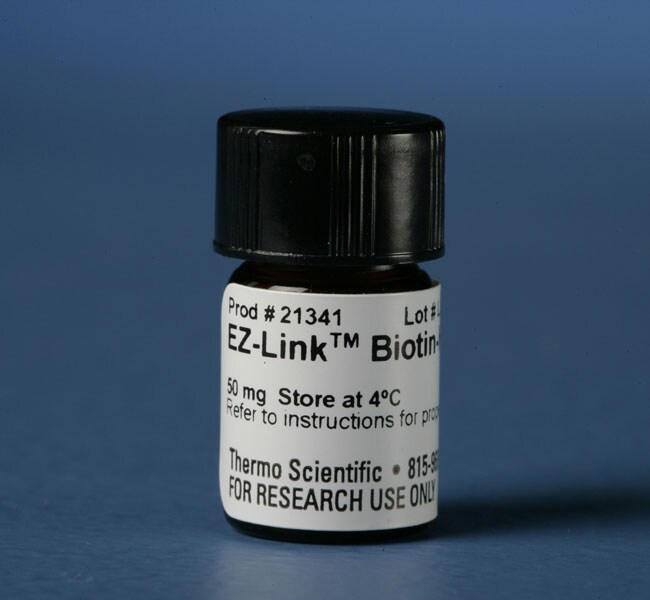
Thermo Scientific EZ-Link HPDP-Biotin is a membrane-permeable biotin labeling reagent that reacts with sulfhydryl (-SH) groups. The resulting disulfide bond between the target sulfhydryl molecule and the biotin group can be cleaved by reducing agents to release the biotin group and regenerate the protein (or peptide) in its original, unmodified form. Labeling with HPDP-Biotin is convenient when using immobilized avidin, streptavidin, or Thermo Scientific NeutrAvidin Protein to purify the target molecules for reducing SDS PAGE or mass analysis; the captured biotinylated molecules can be efficiently eluted from the support by cleaving the disulfide bond with dithiothreitol (DTT) or other reducing agent rather than by attempting to dissociate the high affinity interaction between avidin and biotin with strong acid or denaturant.
Thermo Scientific No-Weigh products are specialty reagents provided in a pre-aliquoted format. The pre-weighed packaging prevents the loss of reagent reactivity and contamination over time by eliminating the repetitive opening and closing of the vial. The format enables use of a fresh vial of reagent each time, eliminating the hassle of weighing small amounts of reagents and reducing concerns over reagent stability.
Features of EZ-Link HPDP-Biotin:
• Protein labeling—biotinylate antibodies or other proteins for use in protein methods
• Thiol-reactive—reacts with sulfhydryls (-SH), such as the side-chain of cysteine (C)
• Pyridyldithiol-activated—perform reactions at pH 6.5 to 7.5 in buffers such as PBS
• Reversible—forms disulfide bonds, which can be cleaved using DTT or other reducing agent
• Solubility—must be dissolved in DMSO or DMF before further dilution in aqueous buffers
• Medium length—spacer arm (total length added to target) is 29.2 angstroms
HPDP-Biotin is a pyridyldithiol-biotin compound for labeling protein cysteines and other molecules that contain sulfhydryl groups. This reagent specifically reacts with reduced thiols (-SH) in near-neutral buffers to form reversible disulfide bonds. HPDP-Biotin is useful for labeling and affinity-purification applications that require recovery of the original, unmodified molecule. For example, a protein can be biotinylated, allowed to bind its interactor, then captured to a streptavidin column and finally eluted and recovered by reduction of the disulfide bond with dithiothreitol.
We manufacture biotin reagents to ensure the highest possible overall product integrity, consistency and performance for the intended research applications.
Biotinylation reagents differ in reactivity, length, solubility, cell permeability and cleavability. Three types of sulfhydryl-reactive compounds are available: maleimido, iodoacetyl and pyridyldithiol. Pyridyldithiol reagents specifically react with sulfhydryl groups (-SH) in near-neutral buffers to form reversible disulfide bonds.
In proteins, sulfhydryls exist where there are cysteine (C) residues. Cystine disulfide bonds must be reduced to make sulfhydryl groups available for labeling. Hinge-region disulfide bridges of antibodies can be selectively reduced to make functional half-antibodies that can be labeled.
Applications:
• Retrieve cell surface receptors and cleave the biotin away on an immobilized avidin column
| Code | Description |
|---|---|
| 21341 | Catalog Number: 21341 |
| A35390 | Catalog Number: A35390 |

